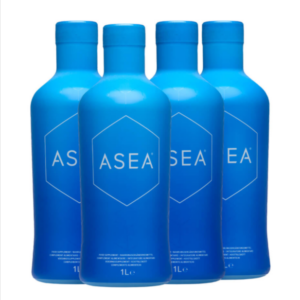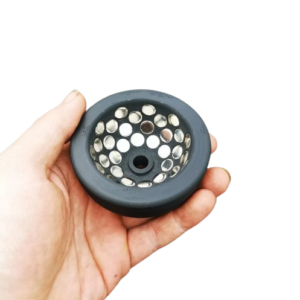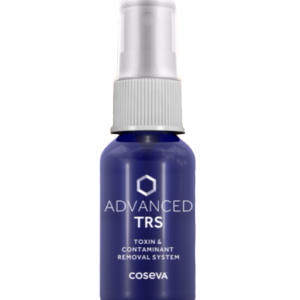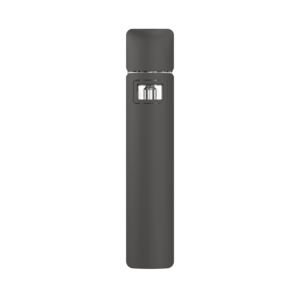Description
• Why don’t supplements work for me?
• Why can’t I get better?
• I’ve tried so many different pills!!
We suggest the use of blood pressure readings for the adrenal sufficiency test click here to be used in conjunction with the variations in temperature method discussed below.
We find the insights of Dr Rind exceptional in understanding metabolic energy as it relates to adrenal and thyroid function. An excellent resource to determine the extent to which an individuals health issues may relate to adrenal problems, thyroid problems or a combination of both.
Note that low metabolic energy can be generally supported with nutrients that help ATP production in the cells, for example Glyconutrients
The information below is reproduced from the website of Dr. Bruce Rind. Please click here to view his website.
Treatment and Diagnosis of Low Metabolic Energy
Where to start: Adrenal vs. Thyroid?
If both the thyroid and the adrenals are weak, adrenal repair must precede thyroid repair. For adrenal repair our experience leads us to suggest that the correct dose of liquorice concentrate is the first remedy of choice, with
DHEA … Click for info
Research has found DHEA to have significant anti-ageing effects. There is evidence to suggest that DHEA supplementation may extend human life and make that life more vital.
DHEA (Dehydroepiandrosterone) is a hormone produced by the adrenal gland, an important endogenous steroid hormone. It is the most abundant circulating steroid in the human body, where it functions predominantly as a metabolic intermediate in the biosynthesis of the androgen and estrogen sex steroids. DHEA also has a variety of potential biological effects in its own right, binding to an array of nuclear and cell surface receptors, and acting as a neurosteroid.
DHEA levels decline at approximately 20% per decade from the age of 25 (the peak of human DHEA production) until we are left with only about 10% or less of these peak levels by the time we are 70. Maintaining healthy DHEA levels may help slow physical ageing and reduce stress.
DHEA may also have an important role in the repair and maintenance of cognitive function
Benefits of DHEA supplementation include:-
• Extended life
• Higher energy levels
• Disease resistance (boosting the immune system)
• Slowing of the ageing process
• Reducing the ill effects of stress
• Decreasing body fat whilst increasing lean muscle tissue
• Enhancing the sex drive
Apart from the above listed general benefits of DHEA, it can also be useful in the prevention and treatment of several serious health disorders, including:-
• Alzheimer’s disease (AD)
• Viral and bacterial infections
• Cancer
• Cardiovascular disease
• Diabetes
• Hypertension
• Osteoporosis
• All autoimmune disorders
The above benefits will be greater and more pronounced when DHEA is used in conjunction with a complete health maintenance programme.
and
Pregnenolone … Click for info
Physicians have recommended hormone replacement therapy to older individuals for many years. Usually the hormones replaced are the end-product hormones: testosterone or estrogen. Recent research suggests that there may be another way. By providing your body with the mother of hormones – Pregnenolone – one can let the body decide through its various feedback mechanisms which hormones it needs.
If more DHEA is required supplemental pregnenolone will be converted to this hormone, and if estrogen or testosterone is in short supply, the pregnenolone molecule will be altered to produce the optimal amount of these. If your physiological requirement is a combination of hormones, then this too, can be achieved.
As the body’s supply of pregnenolone diminishes, so does the availability of its other related hormones. This has led scientists to consider pregnenolone supplementation as a way to turn back the clock on aging and counter the consequences of this dramatic drop in hormone levels.
By its very nature, pregnenolone works with your body to achieve optimal health and longevity. Pregnenolone’s many functions underscore its role as one of the most important hormones in the human body. Pregnenolone reduces fatigue and increases endurance. It also provides the brain with the hormonal and neurotransmitter support it needs to retard memory loss, thus helping to improve concentration and focus.
Moreover, it helps those with arthritis, depression, and traumatic injuries. Although pregnenolone has long been overlooked because it is “upstream” on the hormone pathway, its many benefits to human health suggest that this vital hormone has just begun to receive the attention it so richly deserves.
Broad spectrum curative and anti-aging effects of Pregnenolone
Dr. Raymond Peat (PhD Endocrine Physiologist) accidentally discovered the effects of pregnenolone when he took some vitamin E containing a residue of pregnenolone that was left over from an experiment in solubility. Peat had been suffering from a variety of complaints, including “inflammation of the arteries, dental abscesses, asthma, migraines, and colitis.” When he took the vitamin E containing some pregnenolone, he immediately felt better, but got sick again when he stopped. Suddenly remembering the presence of pregnenolone in the vitamin E, he crawled out of his sick bed, took a pinch of pure pregnenolone and felt immediately better.
All of his symptoms gradually disappeared and in ten weeks, his appearance changed. Many aging characteristics, such as sagging skin, “chicken neck,” bags under the eyes, etc. receded. These changes were dramatically evidenced in a passport photo, taken one year before pregnenolone and 10 weeks after pregnenolone therapy was initiated. When I saw these startling photos, I fell off my chair, dashed to the phone and called Dr. Peat.
Pregnenolone – A Fruit Of Cholesterol By Lita Lee, Ph.D
Caution:
One customer has reported adverse affects of Pregnenolone supplementation due to Oestrogen sensitivity. Clinical trials have not shown this to be a concern, however, for those with known Oestrogen sensitivity issues we would prefer that you err on the side of caution and therefore recommend very slowly introducing Pregnenolone; we would suggest starting at 1/5 of a capsules content daily and maintaining that level for two weeks before increasing to 1/4 daily and so on. Further, we would recommend a similar approach for those who are intending to use Pregnenolone alongside Oestrogen supplementation. Please do not hesitate to contact us with any queries or concerns.
being long term enhancements.
If the adrenals are weak, then even normal thyroid activity places an excessive burden on them. One may begin to feel:
‘Hypo-adrenal’ (coldness, weight loss, dryness, fatigue, insomnia, and/or anxiety)
and then the body innately turns down its own thyroid energy production by increasing production of RT3. (A thyroid ‘brake’ hormone)
Conversely, if the adrenals are strong and the thyroid is weak or unable to keep up with the adrenals, one begins to feel:
‘Hypo-thyroid’ (heat intolerance, weight gain and fluid retention, tiredness, excessive need to sleep and/or depression).
A very common error made by medical practitioners is to focus entirely on the thyroid and ignore the adrenals. In a weakened adrenal state, prescribing thyroid medication that contains T4 and/or T3 may produce limited or transient improvement. Subsequent increases of the dose offer little or no benefit as the medication pushes the energy machinery into overdrive. Unfortunately, this higher energy level is unsustainable due to the stress on the adrenals. Eventually the adrenals become fatigued and the symptoms of low energy return. If, however, the adrenals are functioning well, the thyroid hormones can do their job and the result is good metabolic energy.
If the thyroid generated energy is excessive for the adrenals’ ability to handle it, the body will down-regulate the thyroid energy as much as it is capable of doing to accommodate what the adrenals can safely handle. Sometimes, in an effort to help the patient feel better, the physician keeps increasing the thyroid dose or even gives a T4/T3 combination like Armour Thyroid or just a T3 support like Cytomel. The problem with this is that it forces the system to function at a higher energy than the adrenals can handle.
Initially the adrenals have enough reserve to handle the higher thyroid energy so the patient feels better. When the (adrenal) reserves are exhausted (this can happen in a few days, weeks or months) the patient can develop fatigue, anxiety, bursts of rapid heart beat or the feeling of such bursts (palpitations) or other symptoms of either high thyroid function or of low adrenal function. This is the ‘crash and burn’ phase of the thyroid treatment which ignores the adrenals’ capacity to handle the thyroid support. It is often followed by a recommendation for an anti-anxiety or anti-depressant drug.
Adrenal Repair Basics
In general, stress hurts the adrenals. We can define stress as anything which challenges our survival, joy, prosperity, security or stability. It is anything which forces our system to adapt (e.g., change of circumstances, temperature, chemistry as in a sudden change of supplements, medication or even change of diet). Infection, lack of sleep or even lack of love are stressors.
Read More… Symptoms of Low Metabolic Energy:
The opposite of stress such as joy, sleep and rest, comfort, peace, security, stability, and good nutrition, are examples of things that help the adrenals. Avoid the stressors and seek out those things that help. Eat more proteins (especially amino acids) and fats (not vegetable oils). Limit carbohydrates, especially sugars. Avoid stimulants and physiologically stressful substances such as caffeine, diet pills, alcohol, cigarettes, etc. If you have allergies, avoid the allergens – common allergens are wheat and dairy.
Note: it’s mainly milk and sometimes cheese that are the diary items that can be problematic. Eggs are generally well tolerated, especially if lightly cooked and even more so taken raw. They are the best most easily digested source of protein we can have
Although this may sound surprising, we actually tend to crave foods to which we are allergic. Metabolic activity (the chemical processes and changes going on in our body) represent a stress. At a level that can be handled by the adrenals, this stress is good for us (Eustress) and maintains life. If metabolic activity is too strong for the adrenals (e.g., excessive thyroid stimulation), it is at a level that is unhealthy (Distress) and wears the adrenals down.
Mold is a common serious stress but difficult to avoid. Reduce as much stress as possible. Even ‘good stress’, such as celebration, can sometimes be excessive for the adrenals. Look for opportunities to experience security, joy and optimism. Learn to avoid negative emotions such as fear (e.g. horror movies), anger, etc. Increase rest – get as much sleep as possible and make the timing as regular as possible. Pushing too hard, excessive work or exercise, and any sleep deprivation stresses the adrenals.
Symptoms of Low Metabolic Energy:
Although many of the symptoms below seem unrelated, they may all stem from the same root problem of low metabolic energy.
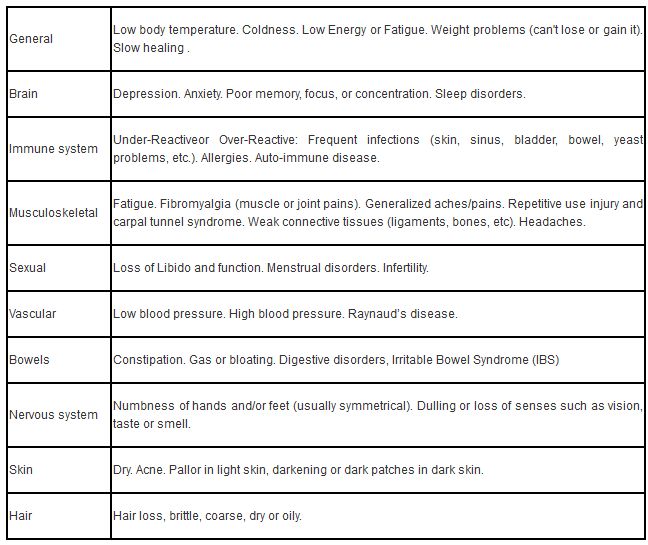
What Causes Low Metabolic Energy?
Every process that goes on inside our bodies requires energy – specifically, metabolic energy. When the body doesn’t have enough energy to function properly, each component of the body will malfunction in its own unique way.
Read More… Poor thyroid and poor adrenal function a mixture of symptoms:
For example, if the brain has too little energy, thought processes such as memory and focus become impaired. The body needs energy to keep itself warm – a low body temperature, therefore, usually accompanies low metabolic energy. (For more examples see the above symptoms list.)
In our cells, ready to use energy is in the form of ATP (adenosine triphosphate) molecules. The body converts fats, sugars, etc. into ATP that is then used for energy. However, there are other factors involved that can affect how well our body can make this conversion from those fats and sugars into the ATP molecules.
The thyroid gland, located at the base of the neck, makes the hormone T4 (thyroxine). T4 converts to T3 (triiodothyronine) and RT3 (reverse T3). The T3 turns on the ATP (energy) making machinery inside each living cell while the RT3 slows it down. Production of these thyroid hormones is controlled by TSH (Thyroid Stimulating Hormone), which is released by the pituitary gland in the brain.
The pituitary takes its orders from the hypothalamus (also part of the brain). The adrenal glands, located on top of each kidney, help the body deal with stress. If the metabolic activity is excessive, the adrenals perceive this as a stress. In response to this stress, the hypothalamus will signal the pituitary to produce less TSH, thus producing decreased T4 and thyroid activity.
Based on the above explanation, some of the contributors to low metabolic energy are:
• The thyroid gland cannot make enough T4 (hypothyroidism). RN: or there is poor conversion from T4 to the more active thyroid hormone T
• The adrenal glands are too weak to handle the stress of the body’s normal metabolic energy and force a down-regulation of energy production.
• The enzymes (cellular machinery) which make ATP may be held back due to chemical interference such as toxins, lack of needed ingredients (vitamins or minerals), or breakdown due to auto-immune disease or old viral damage. RN This can be corrected with Glyconutrients
• Hormonal imbalance such as growth hormone, testosterone, estrogen, or progesterone.
• Severe caloric restriction.
As discussed earlier, when one or a combination of these factors is in place the symptoms of low metabolic energy – such as fatigue, weight issues, memory loss, cold hands, dry skin – may start to appear.
Diagnosing Metabolic Energy Problems
To restore energy to a healthy level, the causative problem(s) must be corrected. Toxic exposure, nutritional deficiencies, food allergies (e.g., to wheat), viral, and auto-immune damage are all, to some degree, universal.
If severe enough, any one of these (or a combination of several lesser ones) can overwhelm the body’s metabolic mechanisms and become the cause of the problem. However, these are not as common as the low metabolism caused by adrenal and/or thyroid dysfunction. The corrections described below relate to the most common causes we see, namely sub-optimal adrenal and/or thyroid function.
Before reading on, I wish to point out an observation I’ve made regarding the relationship of the thyroid to the adrenals. They seem to have an inverse relationship. How we appear (physically, emotionally, chemically etc. seems to be a function of how the thyroid and adrenals relate to each other.
A low adrenal function can appear like an excessively high thyroid function (e.g., both may be thin, nervous, have palpitations, be pale, have unstable temperatures etc). A low thyroid function may appear as high adrenal function (e.g., both may appear heavier than expected, have a reddish facial complexion, have stable temperatures, be or appear calm etc).
If poor thyroid function is the only cause, we typically see a reddish complexion, thinning of the outer eyebrows, easy weight gain, depression, sluggishness, excessive sleep, high blood pressure, and a decreased ability to fight infection. Conversely, if poor adrenal function is the only cause, we typically see pallor, full eyebrows, difficulty gaining weight (if the problem is severe), difficulty losing weight (if the problem is moderate), anxiety, exaggerated startle reflex, insomnia and un-refreshing sleep, low blood pressure, allergies and auto-immune problems.
Most people have a mixture of poor thyroid and poor adrenal function rather than purely one or the other, and therefore a mixture of symptoms:
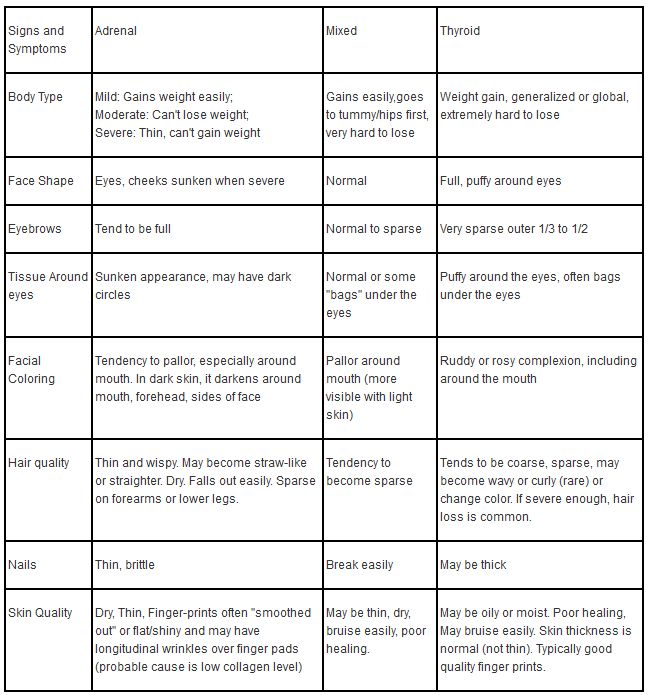
Interpreting Results
See how many symptoms are in each column (adrenal, thyroid, or mixed). This will tell you if our condition is predominately low function of thyroid, adrenals, or a mixture of both.
Read More… Temperature pattern, proper adrenal support:
Nobody has all the above symptoms, however, the more severe the problem the greater the number of symptoms will be present. RN: This is a shortened chart, to see the full chart visit Dr Rind’s website here
Are My Metabolic Energy Problems Due to Low Adrenal or Thyroid Function?
You’re worn down, you have trouble sleeping, you have weight problems, you have a hard time remembering things or focusing, you can’t seem to stay warm. The diagnosis for many of these symptoms is low metabolic energy, the cause in many cases is either adrenal fatigue or low thyroid function.
Yes, these are two rather different issues. The adrenals help us manage stress and maintain stability, while the thyroid turns on energy product. There are unique signs and symptoms that correspond to the dysfunction in each.
Recognizing Adrenal and Thyroid Patterns
In working with thyroid and adrenal problems, I have come to appreciate a most interesting and significant observation. Symptoms of adrenal function and thyroid function are opposite one another.
Thus, in low adrenal function, we see weight loss, pallor, hyper-reactive systems, etc.
While, in poor thyroid function, we see weight gain, reddish complexion, hypo-reactive systems, etc.
This ‘opposite’ pattern has powerful implications in diagnosing and treating individuals in a low metabolic state because it allows the root problem of either adrenal or thyroid dysfunction to be addressed.
The general exception to this pattern is in cases where the symptom is due to general low metabolic energy regardless of whether it is caused by thyroid or adrenal dysfunction.
For example, both poor thyroid and poor adrenal function can cause hair loss or poor mental memory and focus. Some interesting observations: Women have a much higher ration of low metabolic energy problems due to adrenal and thyroid dysfunction: ratio is approximately 8:1. Light skin individuals have a tendency toward weaker adrenals and dark skin individuals have a tendency toward weaker thyroids while olive skin individuals tend not to have weak adrenals or thyroids.
Track Your Temperature: A Quick and Easy Way to Determine Metabolic Health
If you’re not feeling quite up to par, take your temperature. Not to determine if you’ve got a fever – rather, temperatures reflect an individual’s metabolic energy state. The average daytime temperature of a healthy individual is 98.6 (37 C) thus making 98.6 the optimal (as opposed to normal*) temperature.
Lower than optimal temperatures reflect a lower than optimal metabolic state which is usually controlled by the thyroid mechanism. Wide variability of temperature reflects an unstable or fatigued adrenal system. Thus, on the road to health, one wants to go from low and/or unstable temperatures to 98.6 and stable if possible. For details of temperature test and a balanced supplement for all Thyroid hormones click here
The Metabolic Temperature Graph™ is an extremely valuable feedback tool that provides a roadmap with which one can see whether they are moving toward or away from a healthy metabolic state. It provides insight as to whether therapeutic efforts are working or not working, as the case may be. This feedback helps guide the treatment program on a daily basis.
It is very important to follow the directions provided to create your own Metabolic Temperature Graph™ as soon as you know you are having a problem with your thyroid and/or adrenals or you suffer from any of the symptoms associated with low metabolic energy. This will provide you a baseline to work from. Once corrective actions are underway, the temperature pattern will show you how your health is progressing.
*Optimal as opposed to Normal. The frequently used term of ‘normal’ refers to a mathematical or statistical situation. Thus, a ‘normal’ state of health probably means you have some medical problems. It may be normal to die at 76 yrs of age, but at 75 years old, you may decide that what you really want is ‘optimal’ health as opposed to ‘normal’. Normal is not the same as optimal, whether it relates to longevity of life, a body temperature or a lab test result.
Recognizing Adrenal and Thyroid Correction Patterns
Although I have documented over a dozen typical temperature correction patterns for an equal number of metabolic dysfunction profiles, adrenal and thyroid temperature correction patterns are the most prevalent.
Is My Adrenal Therapy Working?
Below is a typical temperature pattern showing what we might see in a person receiving proper adrenal support, having an average to good response:
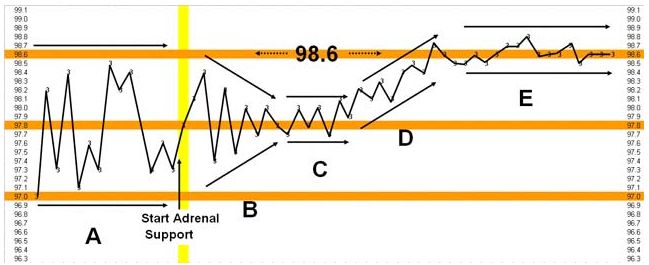
Diagram Key and Explanation:
• A: Unstable temps: adrenal fatigue. Core temperatures have wide variations. They tend to rise in warm weather and fall in cold weather.
• B: Decreasing variability: with adrenal support, as the adrenal gland function improves, (or if supplementing with cortisol) variability decreases (temps become more stable)
• C: Low but stable: after the temperatures have stabilized they still remain low but relatively stable.
• D: Stable and rising: after a period of being stable, the next phase of improvement is a gradual rise in average core temperature.
• E: Stable 98.6º F: This is typical of a healthy metabolic state.
If the adrenal support is working well, phases A through D can each last from one week to several months depending on the individual. In any given individual each of the phases seems to last approximately the same length of time (i.e. short period vs. long period). Some phases can blend together. For example, A and D can combine into an upwardly stabilizing pattern without C being present. I have actually seen some people go directly from A to E.
To go from A to E can take as little as 1-2 weeks or as long as a few months. Hopefully, phase E will be permanent. If the adrenal fatigue is more severe (usually of longer duration), each of phases A through D tends to last longer and phase E tends to be less secure. If no progress is seen in 2-3 months, there is usually another problem present, such as toxicity etc.
Is My Thyroid Therapy Working?
Below is a typical temperature pattern showing what we might see in a person receiving proper thyroid support, having an average to good response. When there are only problems with the thyroid, the pattern is amazingly stable and we tend to see straight line patterns.
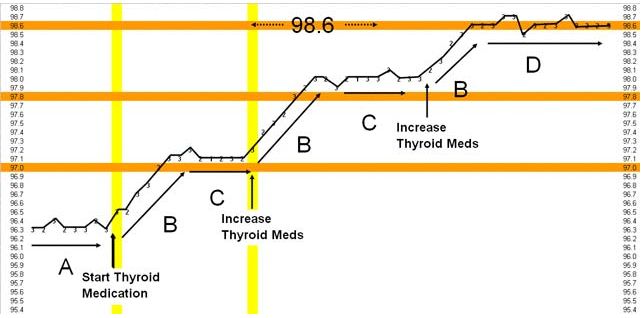
Diagram Key and Explanation:
• A/C: Stable and Low: Baseline temperatures. Low temperature reflects lower than optimal thyroid activity
• B: Stable and Rising: After starting or increasing the dose of thyroid hormone replacement medication, the temperature steadily rises stable but Plateaued: The temperatures plateau at the metabolic level to which the current dosage of thyroid replacement medication can take it.
• D: Stable 98.6º F: Eventually when the proper dose of thyroid replacement medication is reached, the temperature is stable at 98.6. Note that if the adrenals can not handle this level of energy, we tend to see an expansion pattern followed by a drop in temperature (see typical temperature patterns)
How to Take and Plot Temperatures
Temperatures are measured orally. Make sure the thermometer is placed deep under the tongue. Take three temperatures approximately three hours apart, starting approximately three hours after waking up.
Read More… If the temperature graph is the road map, the explanatory notes are the road signs.
For example, if one wakes up at 6 AM, measure temperatures around 9AM, 12 Noon, and 3 PM. Try to avoid taking temperatures after activity or eating and drinking for at least 20 minutes. Even climbing a flight of stairs can raise one’s temperature for short period of time. Taking one’s temperature several times in a row will yield temperatures that rise each time.
This is usually due to the muscular activity of the tongue and mouth. So, take only one reading. I have found digital oral thermometers most appropriate for monitoring metabolism. There are many good models available. I have found the Lumiscope Digital Thermometer to be one of the most accurate for the price and use these with my patients.
I do not recommend mercury thermometers because: they expose you and the environment to toxic mercury when they break; they are too slow; and, the accuracy depends on leaving them in your mouth the same length of time each time you measure. I do not recommend axillary temperatures because the axillae are relatively cooler and more variable in people with stressed adrenals.
Ear thermometers are the least accurate of all. RN one can purchase a digital thermometer locally and check its accuracy by comparison with a glass clinical thermometer a few times. Add or deduct the error when taking readings with the digital thermometer. Modern digital thermometers are very convenient and only take about 15- 30 seconds to give a reading.
Interpreting Results
Interpreting the collected data is both a science and art. These are a few of the basic principles.
Thermal activity reflects metabolic activity. A low temperature means low metabolism and vice versa. For example, the temperature typically found in someone who is old, frail, pale and weak is low and typically ranges from 95 to 97 degrees if no infection is present.
A healthy person will have an average temperature of 98.6 degrees, but may have a 100 degree or higher temperature in a hyperthyroid state or as high as a 104 to 105 degree temperature if there is a fever present these are high metabolic states.
Wide variability in daily temperatures indicates a weak adrenal function since the adrenal glands help the body maintain stability. Good adrenal function produces a stable temperature. As adrenal function improves, the temperature variability decreases and vice versa. As adrenals get stressed (either from emotional stress, excess metabolic stimulation such as excessive thyroid stimulation, or for other reasons), the variability increases.
In a hypothyroid state, the day-to-day averages are low and very stable. In a hypoadrenal state including adrenal exhaustion or adrenal stress, the temperatures are low and unstable — one day they may average 96 degrees and one to two degrees higher the next day.
If the temperature graph is the road map, the explanatory notes are the road signs. Without them, the pattern changes become very difficult to interpret. These notes provide context for the temperature data. They also reveal what components of the treatment program are working and what components or other factors are not.
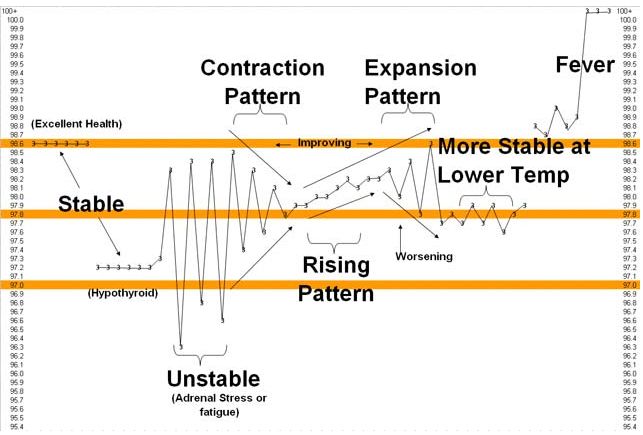
Descriptions for typical patterns that one can observe include:
• Stable: Seen in excellent health or hypothyroid.
• Unstable: Poor adrenal function.
• Contraction pattern: The temperature variability decreases in a cyclic fashion that encompasses one or more days per cycle. It shows a pattern that is stabilizing, implying that the adrenals are not as stressed as before. This happens either because they are stronger or because a burden has been lifted from them such as less thyroid stimulation or a successful end to a stressful situation.
• Rising pattern: This pattern is seen when there is improvement in the metabolic energy. The pattern can be stable or unstable, but the movement is in an upward direction.
• Expansion pattern: The variability increases. It shows a pattern that is becoming less stable implying greater stress on the adrenals and a decreased ability to handle the current (adrenal) burden. It is often seen within the onset of stress (e.g., ‘the in-laws are moving in for a month’) or increased metabolism beyond adrenal tolerance due to taking thyroid hormones/glandular at a dose/ dose introduction regime that is too fast/much for the adrenals, (anyway you should not be doing this!) support adrenals click her for adrenal max resulting in an unstable metabolic state and thus a challenge to the adrenals
• More stable and lower temperature: This is often the end result of an expansion pattern and is seen at the end of the expansion pattern. The body temperature drops to lower level that is more easily sustained or tolerated by the adrenals.
• Fever pattern: A sudden rise in the temperature usually lasting one or more days and then dropping back down to the original baseline. A prolonged infection can produce a long lasting temperature elevation.
For more information concerning thyroid and adrenal symptoms click here to visit Dr Rind’s Website
